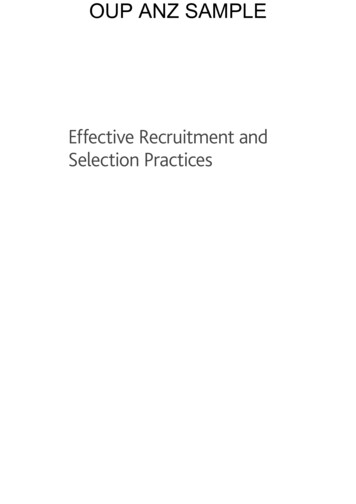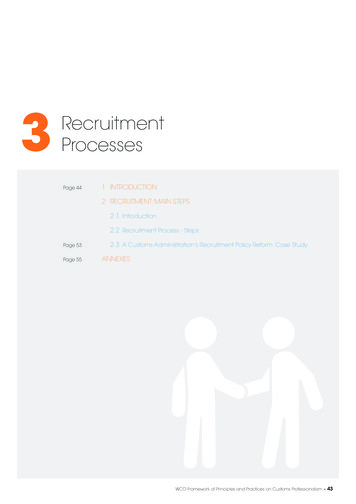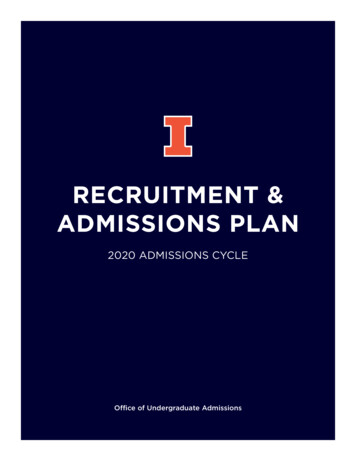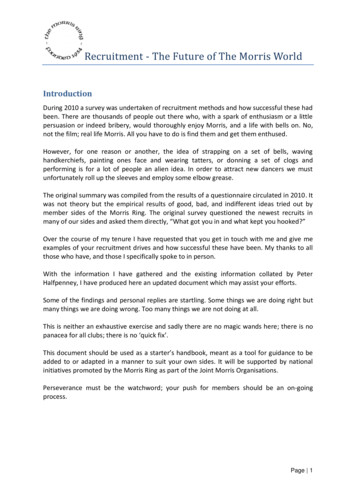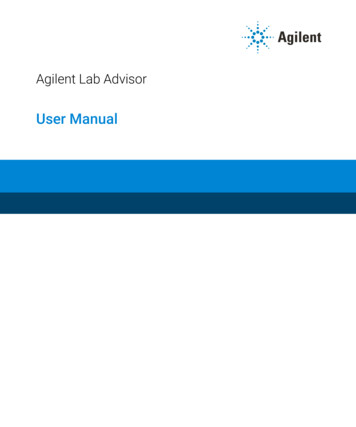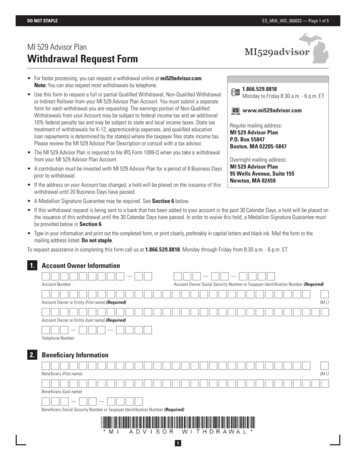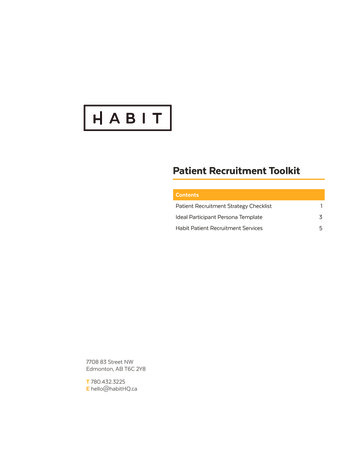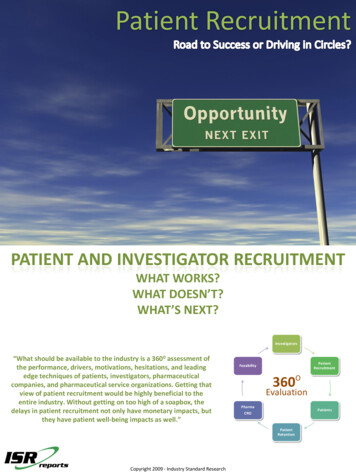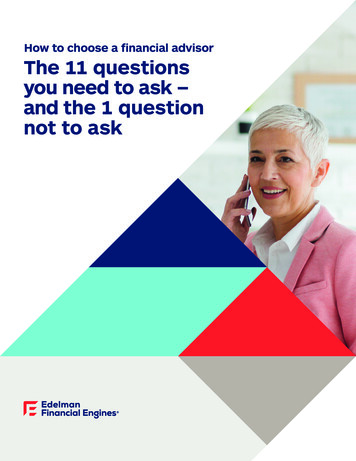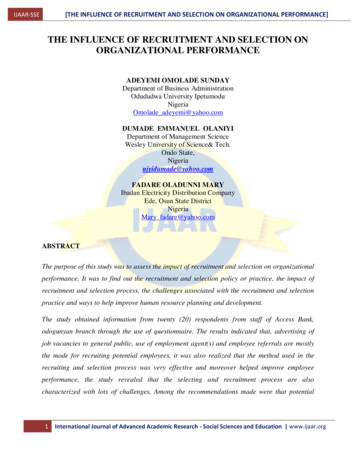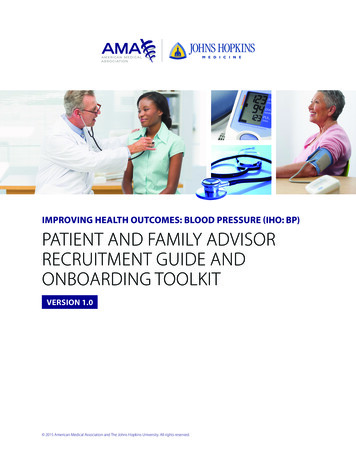
Transcription
IMPROVING HEALTH OUTCOMES: BLOOD PRESSURE (IHO: BP)PATIENT AND FAMILY ADVISORRECRUITMENT GUIDE ANDONBOARDING TOOLKITVERSION 1.0 2015 American Medical Association and The Johns Hopkins University. All rights reserved.
Table of contentsBackground and purpose of this guide and toolkit.3Benefits and importance of patient and family advisors.3Roles and responsibilities of practices and patient and family advisors.3Selection criteria for patient and family advisors.4Recruitment strategy for patient and family advisors.4Patient and family advisor recruitment and resources.4Patient and family advisors orientation session.5Ongoing patient and family advisor engagement.6Overview of appendices.6Appendix 1: Recruitment handout.9Appendix 2: Recruitment flier.10Appendix 3: Recruitment letter.11Appendix 4: Application form.12Appendix 5: Interview protocol.14Appendix 6: Sample offer letter.17Appendix 7: Sample regret letter.18Appendix 8: Participation considerations letter.19Appendix 9: Orientation session slide deck.21Appendix 10: “Talking about your experience” questionnaire.22Appendix 11: Messaging guide.25References.262PFA recruitment guide and onboarding toolkit 2015 American Medical Association andThe Johns Hopkins University. All rights reserved.
1. Background and purpose of this guide and toolkitThis guide and toolkit, created by Johns Hopkins Medicine in collaboration with the American MedicalAssociation’s “Improving Health Outcomes: Blood Pressure” (IHO: BP) initiative, are intended to help facilitate therecruitment and orientation process for engaging patients and families as advisors in the planning, delivery andevaluation of care in your practice. Engaging patient and family members as advisors is worth considering ifyour practice can devote time to organizing their involvement.We’ve created this guide and toolkit to be adapted to meet the needs of your practice/health center. Mostof the examples in this guide and toolkit use blood pressure or hypertension as an example; however, theinformation and materials can be adapted for other chronic diseases and/or used for other initiatives.Patient engagement for ambulatory practicesAmbulatory practices may find it helpful to engage patients in their quality improvement (QI) work.1 Here aretwo ways you can engage patients and families: Partner with patients and families in self-management Engage patients and families in your QI work as advisorsHospitals and health systems have long recognized the benefits and importance of patient and family advisorycouncils.2 As a result there are many resources available for inpatient-based patient and family advisory groups.Ambulatory practices interested in engaging patient and family advisors (PFAs) may find that few resources existto provide guidance on how they can recruit and work with PFAs. This guide and toolkit are intended to help fillthat gap.2. Benefits and importance of patient and family advisorsEvidence is growing that meaningful patient and family engagement can help achieve the triple aim ofbetter quality, better outcomes and lower health care costs, and can also substantially reduce preventableharm. Patient and family engagement is associated with improved patient quality and safety and betterhealth outcomes.3Partnering with patients and families helps “patients make more informed choices about their care, usemedications more safely, practice more effective self-management, contribute to infection-control initiativesand help reduce medical errors—all translating into measurable improvements in the quality and safety of care.”Engaged patients also have better management of chronic conditions and overall improved functioning.33. Roles and responsibilities of practices and patient and family advisorsIn order for practices and PFAs to work together effectively, it is critical to establish and communicate roles,responsibilities and expectations. These responsibilities should be outlined in the participation considerationsletter and discussed at the in-person orientation meeting (see No. 7 below, “Patient and family advisorsorientation session”). This guide includes a sample “Participation considerations letter” document that can beused as a template (see Appendix 8).PFAs may serve in multiple roles and multiple terms may also be used to describe their role. Three of thecommon roles for PFAs are: Advisor: Enables patients and families to have direct input and influence on the policies, programs andpractices that affect the care and services individuals and families receive4 Advocate: Promotes patient-centeredness, patient safety and the patient voice in the health care system5 A mbassador: Builds positive relationships with the health care community and works in partnershipwith other ambassadors and health care professionals to promote the perspectives of patients and otherstakeholders63PFA recruitment guide and onboarding toolkit 2015 American Medical Association andThe Johns Hopkins University. All rights reserved.
If you will be compensating your PFAs for their work, this should also be specified in the participationconsiderations letter. Hourly stipends or honoraria can typically range from 12 to 25 per meeting.7 At aminimum, PFAs should be reimbursed for any expenses incurred to attend meetings (e.g., transportation, childcare, etc.). You may also provide gift cards, vouchers or other types of incentives.4. Selection criteria for patient and family advisorsWhile there is no single definition of an ideal candidate to serve as a PFA, “experience from existing programssuggests that important considerations are the patients’ abilities to work with the health care team, theirbreadth of experience with the health care setting, their ability and willingness to communicate concerns, and[their] ability to represent patients and families broadly rather than focus narrowly on a particular issue.” 8Individuals selected as patient and family advisors should: Show passion for patient-centered care and for individuals and populations with chronic conditions(such as hypertension) Have experience working in teams, with a strong preference for those with prior positive experiencesserving as PFAs in health care settings Have experience in managing chronic conditions, either in themselves or a loved one Reflect demographic diversity (e.g., race/ethnicity, age and sex)5. Recruitment strategy for patient and family advisorsThe number of patient and family advisors your practice chooses to work with will be based on the needs,size and resources of your practice. Recruiting at least two PFAs is strongly encouraged. Experience fromother patient and family advisory groups has shown that working with two or more PFAs can produce robustengagement.9You may choose to recommend individuals who are patients within your practice who might be well-suited toserve as a PFA (See No. 4 above, “Selection criteria for patient and family advisors”) or you may partner with localhospital and/or health plan patient/family advisory councils to help identify candidates.6. Patient and family advisor recruitment and resourcesFigure 1. Patient and family advisors recruitment processThe graphic below provides an overview of the major activities that are involved in the PFA recruitment process.(See next page for checklist of tasks to complete these We recommend that your entire practice team get involved. Physicians can help to identify patients, andpractice staff (e.g., office manager, front desk staff, and/or medical assistants) can manage other steps for PFArecruitment and orientation, since they may also interact with patients and their families. Feel free to modify thesteps and roles depending on your workflow and practice resources.4PFA recruitment guide and onboarding toolkit 2015 American Medical Association andThe Johns Hopkins University. All rights reserved.
Patient and family advisor recruitment checklistOutreachDevelop recruitment criteriaAsk practice staff and physicians for referrals Partner with local hospital and/or health plan patient/family advisory councils to help identifycandidatesUse recruitment handouts, fliers, etc. (see appendices 1, 2 and 3)IdentifyIdentify candidatesCreate application processUse application form (see Appendix 4)InterviewConduct interviews with candidatesUse interview protocol (see Appendix 5)SelectSelect advisors (number determined by your practice)Use sample offer/regret letters (see Appendix 6 and Appendix 7)Use participation considerations letter (see Appendix 8)OnboardConduct an orientation sessionUse orientation agenda and other resources7. Patient and family advisors orientation sessionAfter you have selected your PFAs and received signed participation considerations letter, you may want toschedule an in-person orientation session with your team members and your PFAs, lasting 45–60 minutes. Theorientation provides you with an opportunity to discuss roles, responsibilities and expectations for both yourpractice site and PFAs. Refer to the appendices for resources that you can use to help guide this meeting.5PFA recruitment guide and onboarding toolkit 2015 American Medical Association andThe Johns Hopkins University. All rights reserved.
8. Ongoing patient and family advisor engagementWhen considering different ways to create and maintain patient and family advisor engagement, it may behelpful to think of the patient and family advisor engagement in terms of informal engagement and formalengagement: Formal engagement refers to ongoing participation of PFAs in teams, working groups, committees, taskforces and panels as equal members. This way they will be fully engaged throughout the process ofdeveloping, implementing and evaluating policies and programs where their advice and perspectivesneed to be incorporated (e.g., engage them in issue identification, research, consultation, development,implementation and evaluation of policies and programs). Informal engagement refers to one-time or ad hoc participation of PFAs, including: Casual consultation with PFAs on developing new, or changing existing, policies/programs thatmay potentially affect patients and families (consultation can be in the form of meetings or phoneconversations) Occasional participation in meetings where perspectives of patients and families are needed fordecision making (e.g., senior leadership team meetings, branch meetings, etc.) Participation in focus groups and surveys Development and review of audiovisual or written materials (e.g., brochures and pamphletsdeveloped to provide information to patients and families or public) Sharing their stories at meetings, conferences and events10Some of the suggestions below can also help ensure PFAs are engaged in your QI work: Devote time to planning and evaluation of council efforts Set priorities and focus efforts on meaningful, collaborative projects Set and achieve measurable goals Track accomplishments and provide positive feedback Create a variety of ways for PFAs to participate in the consideration of issues (e.g., conference calls,written review of materials)11 Ask for the opinions of PFAs during discussions, encouraging their participation and validating their role Keep them informed about how their feedback and ideas contribute to changes and improvementsOverview of appendicesThe following is an overview of the tools you can use to recruit and onboard PFAs, help orient them to theirroles and responsibilities, and help your practice site staff make the best use of PFAs.Feel free to use all or just a few of these resources, depending on the objectives of your practice. Wherepossible and/or applicable, we have included placeholders and prompts to help you customize these materialsfor your practice.Materials for PFAs can be distributed during an initial, in-person onboarding meeting (see No. 7 above, “Patientand family advisors orientation session”). Distribute materials for relevant practice site staff during the PFArecruitment and selection process.To receive customizable versions of the below tools, or if you have any feedback about thistoolkit, please contact Sara Alafogianis at sara.alafogianis@ama-assn.org.6PFA recruitment guide and onboarding toolkit 2015 American Medical Association andThe Johns Hopkins University. All rights reserved.
List of recruitment and onboarding tools for patient and family advisors7ResourceUse this to DescriptionAppendixRecruitmenthandoutProvide potentialcandidates withdetailed informationabout patient andfamily advisors (PFA)roles and benefitsTwo-sided handout for potential PFAs,includes description of who is eligible toapply to be a PFA and how they canlearn more1RecruitmentflierProvide potentialcandidates with anoverview of PFA rolesand benefitsOne-page sheet for potential PFAs withinformation about being a PFA, includingwho is eligible to apply and how they canlearn more2RecruitmentletterReach out topotential candidatesLetter to potential PFAs on roles,responsibilities, benefits; who is eligible toapply, how they can learn more (to be sentwith handout or flier above)3ApplicationformScreen potential PFAcandidatesInterested PFA candidates complete thisthree-page document or online survey,collects basic demographic information—i.e., why the individual wants to be anadvisor, what experiences he/she has had asa patient, family member and/or volunteer4InterviewprotocolScreen potential PFAcandidatesOne-page, semi-structured interviewprotocol to obtain qualitative informationand help determine if candidate will be aneffective and engaged PFA5Sampleoffer andregret lettersNotify PFAcandidates ofselection decisionsOne-page letters to PFA candidates whohave or have not been selected to serveas PFAs (note: selection letters should beaccompanied by a phone call to confirmacceptance)6(Offer etterCreate an agreementbetween thepractice and PFAA one to two-page participationconsiderations letter formally establisheseach PFA’s acceptance of terms forparticipation as a patient and family advisor8PFAorientationsession slidedeckProvide informationfor new PFAs. (TheIHO: BP initiative isused as an example).Overview of expected PFA roles andresponsibilities based on examples fromthe IHO: BP initiative9PFA recruitment guide and onboarding toolkitPowerPoint presentation available 2015 American Medical Association andThe Johns Hopkins University. All rights reserved.
8ResourceUse this to DescriptionTalkingabout yourexperience:QuestionnaireHelp PFAs talk abouttheir experiencesOne-page handout facilitates sharing ofrelevant health care experiences that can beused for an interactive exercise during thePFA orientation10MessagingguideHelp PFAs effectivelyand consistentlycommunicate withexternal audiencesBrief talking points that can be provided toPFAs for standard messaging about their role11PFA recruitment guide and onboarding toolkitAppendix 2015 American Medical Association andThe Johns Hopkins University. All rights reserved.
Appendix 1Recruitment handoutBECOME A PATIENT AND FAMILY ADVISOR FOR PRACTICE NAME What is a patient and family advisor?A patient and family advisor is someone who: Helps improve the patient experience and quality of carefor those with chronic conditions Gives feedback based on his or her own experiences asa patient or family member of someone with a chroniccondition Works with the practice team for either short or long-termcommitments, depending on the project Volunteers his or her time (usually at least one hour and notmore than four hours per month)patients. Review or help create educational or informationalmaterials. Advisors provide a patient perspective andhelp us make forms or educational handouts easier for allpatients and family members to understand and use. Partner with community. Discuss what programs orresources could be offered in the community to helpsupport patient self-management of chronic conditions Work on short-term projects.We sometimes ask advisors to help us make improvements. Forexample, helping to design a patient self-management plan.Who can be a patient and family advisor?Is being a patient and family advisor right for you?You do not need any special qualifications to be anadvisor.Being a patient and family advisor may be a good match withyour skills and experiences if you can:What’s most important is your experience as a patient or familymember. We will provide you with any other training you need.Why should you become a patient and familyadvisor?Patient and family advisors provide a voice that advocates forproviding health care services centered on patient- and familyidentified needs, rather than the assumptions of what patientsand families want.For example: When you or your family member visited a doctor’s office,did you think there were things that could have been donebetter? Do you have ideas about how to make sure other patientsand families get the best care possible?If yes, we are looking for patient and family advisors like you togive us feedback and ideas to help us improve the quality ofcare for patients with chronic conditions.What do patient and family advisors do? Speak up and share suggestions and potential solutions tohelp improve chronic condition care for others Talk about your experiences as a patient or familymember—but also think beyond your own personalexperiences Talk about both positive and negative care experiences andshare your thoughts on what went well and how thingscould have been done differently Work with people who may be different from you Listen to and think about what others say, even when youdisagree Bring a positive attitude to discussions Keep any information you may hear as an advisor privateand confidentialFor more information about being a patient and family advisor,including how to apply:Call: Insert contact name and phone number Email: Insert contact name and email address [NOTE: Personalize this section for your practice as appropriate.] Talk about your experience. Advisors help by talking abouttheir health care experiences with doctors, staff and otherThis piece was adapted from the “Become a Patient and Family Advisor” brochure for hospitals. Strategy 1: Working With Patients and Families asAdvisors. June 2013. Agency for Healthcare Research and Quality, Rockville, Md. ngfamilies/strategy1/index.html9PFA recruitment guide and onboarding toolkit 2015 American Medical Association andThe Johns Hopkins University. All rights reserved.
Appendix 2Recruitment flierDo you have ideas to help improve care forpatients at this practice?BECOME A PATIENT AND FAMILY ADVISOR Modify flier to fit your practice/health center needs What is a patient and family advisor? A patient and family advisor is someone who helps improve the quality of the treatmentexperience for patients with chronic conditions such as high blood pressure.What do patient and family advisors do? Talk about your experience. Advisors help by talking about their health careexperiences with doctors, staff and other patients. Participate in discussion groups. Advisors tell us what it’s like to be a patient andhow we can improve the care we provide. Review or help create patient education materials. Advisors help review orcreate materials like forms and educational handouts. Advisors provide a patientperspective and help us make these materials easier for all patientsand family members to understand and use. Partner with the community. Discuss what programs or resources could be offeredin the community to help support patient self-management.Why should YOU become a patient and family advisor? If you or a family member has received treatment for a chronic condition suchas high blood pressure, you could help to bridge the gap between how patientsexperience treatment and how their physicians perceive the care they provide.For more information about becoming a patient and family advisor, contact: Insert your practicelogo here Call: INSERT contact name and phone number Email: INSERT contact name and email address For more information about the AMA’s strategic focus to improve health outcomes, visit:ama-assn.org/go/hypertensionJoin us! Together we can work to improve patients’ care experiences!10PFA recruitment guide and onboarding toolkit 2015 American Medical Association andThe Johns Hopkins University. All rights reserved.
Appendix 3Recruitment letter Date Dear Name ,Your name came to us by way of INSERT referral source , and we would like to formally invite you toconsidering becoming a “patient and family advisor” for INSERT practice/health center name ’s efforts tohelp patients who have high blood pressure OR other condition (specify) .The INSERT practice/health center name team is committed to creating an environment where the needsof patients and families drive the healthcare experience. Patient and family advisors will: Provide a patient perspective for providing health care services that are centered on patient- and familyidentified needs, rather than assumptions about what patients and families may want. Offer suggestions on tools and techniques that will help patients self-manage their chronic conditions,such as high blood pressure. Receive a INSERT amount for attending meetings and participating in telephone calls andreimbursement for any approved travel-related expenses needed to attend in-person meetings, inappreciation of their time and unique expertise DELETE this text if not applicable .I’ve attached two documents for you to read:1. A brochure with more information about becoming a patient and family advisor2. An application for you to fill out if you are interested in becoming a patient and family advisorI’ve also attached an application form. Please complete it and return it to us by INSERT date if you areinterested in joining us in our efforts to making our practice/health center more patient-focused.I hope you will consider becoming a patient and family advisor for INSERT practice/health center name .Please feel free to contact me if you have any questions.Sincerely, Practice Contact for Patient and Family Advisors Position/Title Additional information (if applicable) Practice/Health Center Address Line 1 Address Line 2 City, State ZIP code P: Phone number F: Fax number email address 11PFA recruitment guide and onboarding toolkit 2015 American Medical Association andThe Johns Hopkins University. All rights reserved.
Appendix 4Application form Insert practice logo or information here Patient and family advisor application formName:Street address:City: State: ZIP code:Preferred contact:HomeOfficeMobileEmailOther (please specify):Home phone: Office phone: Mobile phone:Email:Please take a few minutes to complete the following questions that will help us get toknow you better.1. Are you a PatientFamily member of a patient2. We recognize that our patient and family advisors have busy lives. How much time are youable to commit to being a patient and family advisor each month? (check one)Less than one hour per monthOne to two hours per monthThree to four hours per monthMore than four hours per month3. Would you be available to participate in two or three in-person meetings a year?(You can still be an advisor if you answer “No.”)Yes NoIf yes, what times would work best for you (select all that apply)?Morning Afternoon Evening Other (please specify):4. Would you be available to participate in a monthly phone call for 30 to 60 minutes?(You can still be an advisor if you answer “No.”)Yes NoIf yes, what times would work best for you (select all that apply)?Morning Afternoon Evening Other (please specify):12PFA recruitment guide and onboarding toolkit 2015 American Medical Association andThe Johns Hopkins University. All rights reserved.
5. How do you want to help? I want to: (check all of your interest areas)Help develop or review informational materials for patients and family membersHelp improve the patient and family role in care decision-makingReview procedures and provide input to improve patient care experienceOther areas of interest (please describe):Please tell us about yourself.6. Why would you like to serve as a patient and family advisor?7. Do you know other individuals or families who might be interested in serving as advisors?If so, please provide us their contact information.Name:Phone: Email:Name:Phone: Email:Name:Phone: Email:Please return this form by mail, fax or email (preferred method) to: Add practice address here Attention: Practice contact for patient and family advisors Phone: add phone Fax: add fax Email: add email 13PFA recruitment guide and onboarding toolkit 2015 American Medical Association andThe Johns Hopkins University. All rights reserved.
Appendix 5Interview protocolPatient and family advisor candidate interview guide and questionsHello, my name is state name . Thank you for taking time to speak with me. I am state position anddescribe role . We are working with the American Medical Association and Johns Hopkins Medicine, whoare partners in leading an initiative called “Improving Health Outcomes: Blood Pressure.” The goal of the initiative,which we call “IHO: BP,” is to improve blood pressure control for patients with uncontrolled high blood pressure,also known as hypertension. Or INSERT your practice/health center initiative information here Before we begin, I’d like to go over a few things. First, our interview should take 30 minutes . There are noright or wrong answers, so please feel open to share your thoughts and experiences when responding to anyquestions. To be sensitive to time, if we find ourselves going off track or topic, I may interrupt you to steer usback to the question. We have a fair amount to discuss and I am eager to hear your thoughts as well as give yousome time to ask me questions. State who is taking notes will be taking notes just to capture the details ofthis interview.Potential interview questions: Modify as needed for your practice/health center initiative 1. We ask this of all candidates: do you or your family have any financial relationships, like stocks or otherinvestments, with health care organizations, such as pharmaceutical companies, hospitals or health plans? This question is to identify any conflict of interest. Delete if not applicable .2. Help us understand a bit more about your background. Please tell us about yourself.(Prompt with examples, such as: Tell us about your educational background, professional experience, familyand hobbies, etc.)3. We’re going to shift gears a bit and spend a little time talking about your past experiences as an advisor oran active volunteer committee member for other programs or organizations. Can you tell us about someof these? (Prompt with examples: assisting to plan an event for a local food bank, school, etc.; working with anadvocacy committee for a health organization; h
hospital and/or health plan patient/family advisory councils to help identify candidates. 6. Patient and family advisor recruitment and resources Figure 1. Patient and family advisors recruitment process The graphic below provides an overview of the major activities that are involved in the PFA recruitment process.
